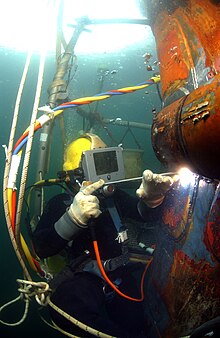
Back Unterwasserschweißen German Soldadura subacuática Spanish جوشکاری زیر آب Persian Podvodno zavarivanje Croatian Saldatura subacquea Italian 水中溶接 Japanese Подводно заварување Macedonian Onderwaterlassen Dutch Spawanie podwodne Polish Sudare subacvatică Romanian


Hyperbaric welding is the process of extreme welding at elevated pressures, normally underwater.[1][2] Hyperbaric welding can either take place wet in the water itself or dry inside a specially constructed positive pressure enclosure and hence a dry environment. It is predominantly referred to as "hyperbaric welding" when used in a dry environment, and "underwater welding" when in a wet environment. The applications of hyperbaric welding are diverse—it is often used to repair ships, offshore oil platforms, and pipelines. Steel is the most common material welded.
Dry welding is used in preference to wet underwater welding when high quality welds are required because of the increased control over conditions which can be maintained, such as through application of prior and post weld heat treatments. This improved environmental control leads directly to improved process performance and a generally much higher quality weld than a comparative wet weld. Thus, when a very high quality weld is required, dry hyperbaric welding is normally utilized. Research into using dry hyperbaric welding at depths of up to 1,000 metres (3,300 ft) is ongoing.[3] In general, assuring the integrity of underwater welds can be difficult (but is possible using various nondestructive testing applications), especially for wet underwater welds, because defects are difficult to detect if the defects are beneath the surface of the weld.
Underwater hyperbaric welding was invented by the Soviet metallurgist Konstantin Khrenov in 1932.[4]
- ^ Keats, DJ (2005). Underwater Wet Welding - A Welder's Mate. Speciality Welds Ltd. p. 300. ISBN 1-899293-99-X.
- ^ Cary, HB; Helzer, SC (2005). Modern Welding Technology. Upper Saddle River, New Jersey: Pearson Education. pp. 677–681. ISBN 0-13-113029-3.
- ^ Bennett PB, Schafstall H (1992). "Scope and design of the GUSI international research program". Undersea Biomedical Research. 19 (4): 231–41. PMID 1353925. Archived from the original on December 14, 2008. Retrieved 2008-07-05.
{{cite journal}}: CS1 maint: unfit URL (link) - ^ Carl W. Hall A biographical dictionary of people in engineering: from the earliest records until 2000, Vol. 1, Purdue University Press, 2008 ISBN 1-55753-459-4 p. 120
© MMXXIII Rich X Search. We shall prevail. All rights reserved. Rich X Search